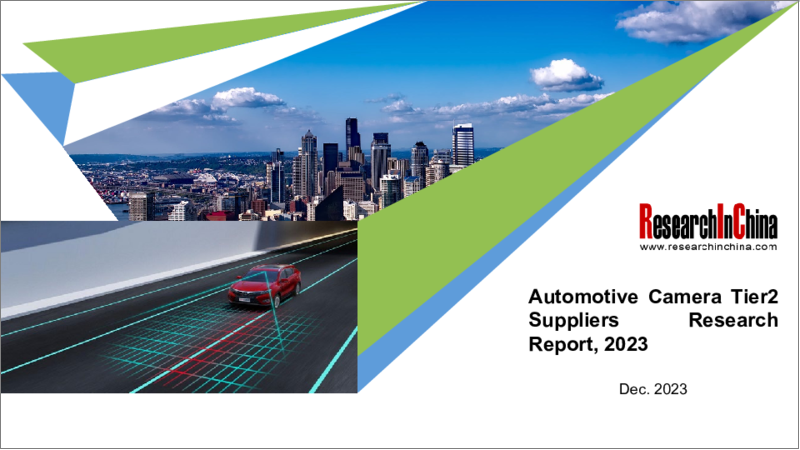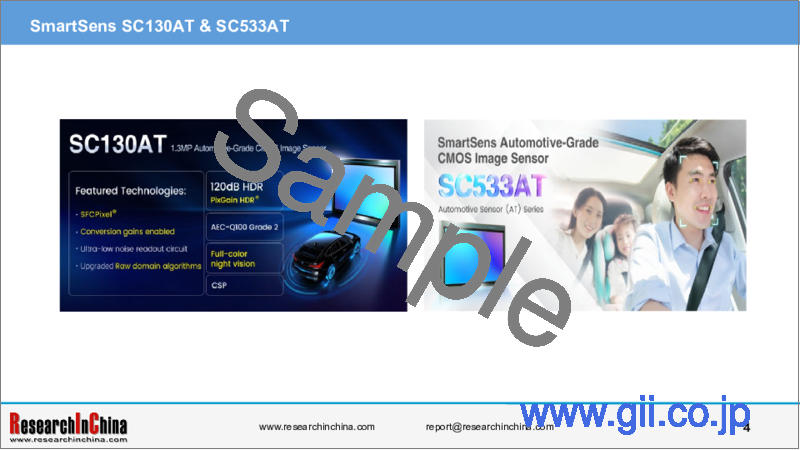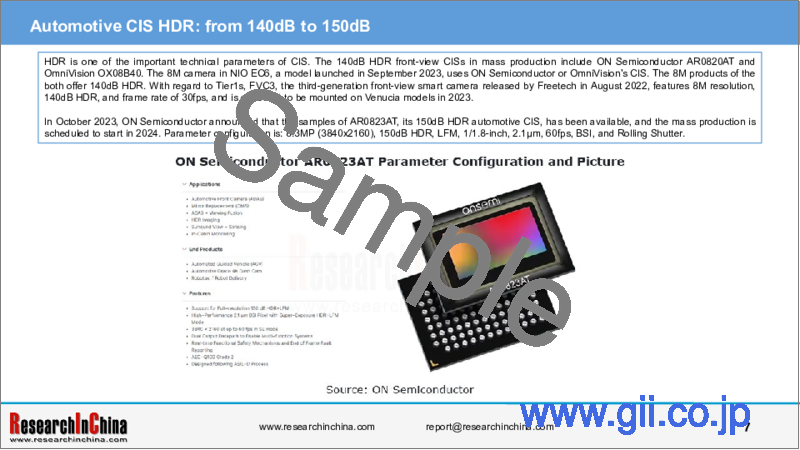|
|
市場調査レポート
商品コード
1400756
車載カメラのTier 2サプライヤーの分析 (2023年)Automotive Camera Tier2 Suppliers Research Report, 2023 |
||||||
|
|||||||
| 車載カメラのTier 2サプライヤーの分析 (2023年) |
|
出版日: 2023年12月07日
発行: ResearchInChina
ページ情報: 英文 300 Pages
納期: 即日から翌営業日
|
- 全表示
- 概要
- 目次
1. 自動車用レンズメーカー:「カメラモジュール部門+新興サプライヤー」が中国製品の台頭を促進
2023年、自動車用レンズ企業は依然として3つのグループに三分された状態が続いています。第一がSunny Opticalで、同社のレンズ製品は販売と技術力の面で依然として業界をリードしており、2023年の市場シェアは依然として40%を占めると予想されます。第二のグループが、Lianchuang Electronic (中国)、OFILM (中国)、Trace Optical (中国)、Guangzhou Jinghua Precision Optics (中国)、Sekonix (韓国)、Nidec (日本)、Maxell (日本) で、市場シェアは5%から10%となっています。第三がPhenix OpticsとLargan Precisionです。
2023年、中国の自動車用レンズ企業は、産業チェーンの川下へと拡大を続けています。その中で、Sunny Smartlead (Sunny Opticalのモジュール工場)、Lianchuang Electronic、OFILM、Guangzhou Jinghua Precision Opticsは、Tier2からTier1への転換に成功し、主に中国の新興自動車メーカーと提携しています。Maxell、Nidec Sankyo、Sekonixといった日本や韓国の同業他社は、依然としてレンズ製品に特化し、Tier 1サプライヤーや従来のOEMメーカーに供給しています。
日韓の同業他社は、依然として市場シェアが大きいにもかかわらず、「新興サプライヤー+カメラモジュール分野の拡大」によって競争力を高めた中国サプライヤーの影響に直面しています。
Sunny Opticalの2023年1月から10月までの自動車用レンズ出荷台数は7,931万6,000個で、2022年同期比19.1%増、車載カメラモジュールの出荷台数は800万個に達すると推定されます。モジュール量産に関しては、Li Auto、Xpeng、Mazda、Toyota、Great Wall、SAIC、Geely、ZEEKRなどが主要顧客です。
Lianchuang Electronicは、2023年1月から10月までに900万個の自動車用レンズを出荷する見込みで、前年同期比で30%以上急増し、車載カメラモジュールの出荷量は300万~400万個に達すると推定されます。カメラモジュールに関しては、Lianchuang Electronicの自動車用光学部品事業は2021年から車載カメラモジュールの展開を開始しており、NIOやBYDと協力して開発を進めています。現在、Lianchuang Electronicの車載カメラモジュール製品は、フロントビュー、サラウンドビュー、リアビュー、DMSなどの分野をカバーしています。量産に関しては、Lianchuang ElectronicはNIOの新世代プラットフォーム向けの8M ADAS車載画像モジュールの主要サプライヤーであり、2022年にNIO ET7とET5に供給され、BYDとLeapmotorなどの自動車メーカーに指定されました。
OFLIMは2023年の最初の10ヶ月間に、自動車用レンズを前年同期比15%以上増の850万個、カメラモジュールを10%増の500万個出荷したと推定されます。カメラモジュールに関しては、OFILMは2015年にShanghai OFILM Intelligent Vehicle Connected Technology Co., Ltd.を設立し、車両カメラモジュールのような知能型運転製品の展開に特化しています。現在、OFILMの車両用カメラモジュール製品は、フロントビュー (モノ/マルチカメラ)、サイドビュー、CMS、サラウンドビュー、リアビュー、DMS、OMSなどの分野をカバーしています。
2. 車載CMOSイメージセンサー (CIS) 市場は、Samsung、SmartSensに次いで3社が独占
現段階では、車載CIS市場は依然としてON Semiconductor、OmniVision、Sonyの3社がリードしています。
2022年には、ON Semiconductorが車載CISの世界市場で最大のシェア約40%を占め、OmniVisionが約25%~30%のシェアでこれに続き、Sonyは約12%~15%のシェアで3位に位置しています。
Samsungがこれに続き、2022年のシェアは約5%~7%です。Hyundai Mobisとの協力に加え、韓国の自動車メーカーの優先サプライヤーとして、Samsungも2022年にTeslaの列車に飛び乗り、TeslaのいくつかのモデルにCISサプライヤー (ISOCELL Auto 4ACを供給) となり、市場ではるかに大きなシェアを誇った。
OmniVision Chinaを除き、大規模供給が可能な中国企業にはSmartSens、BYD Semiconductor、GalaxyCoreなどがあります。2017年に設立され、上海に本社を置くSmartSensは、フロントビュー (8M)、サラウンド/リアビュー (1M~2M)、コックピット (3M~5M) をカバーする自動車用CIS製品を有しており、BYD、FAW、SAIC、Dongfeng Nissan、Great Wall、Leapmotor、Voyahなどの自動車メーカーのプロジェクト向けに産み出され、世界市場シェアは約3~5%となっています。
2023年にリリースされるSmartSensの新製品には、SC130AT (2023年6月リリース) とSC533AT (2023年8月リリース) があり、2023年第4四半期に量産される予定です。
SC130ATは既にサンプルが顧客に出荷されており、2023年第4四半期に量産開始予定です。解像度は1.3M (1304Hx984V)、120dB HDR、BSI、ローリングシャッター、フレームレート30fps、画素サイズ3.75μm、光学フォーマット1/3型となっています。
SC533ATのサンプルも顧客に出荷済みです。量産開始は2023年第4四半期を予定しています。解像度は5.3M (2592Hx1944V)、RGB-IR、BSI、グローバルシャッター、寄生光感度 (PLS) 20000、フレームレート60fps、ピクセルサイズ2.2μm、光学フォーマット1/2.53インチとなっています。
GalaxyCoreは2003年に設立され、本社は上海にあります。同社の製品は主にドライブレコーダー、バックカメラ、360度サラウンドビュー、リアビューなどに使用されています。2023年上半期、GalaxyCoreはアフターマーケットで1億人民元以上 (総収入の約5.1%) を販売しました。
3. 自動車用CISの解像度:8Mから17.4Mへの大躍進
現在、主流の自動車用ADAS CISの解像度は8Mまで発展しています (代表的な製品には、ON SemiconductorのAR0820ATや、SonyのIMX424です)。8Mカメラの検出範囲は1.2Mカメラの2倍以上です。12Mと15Mのカメラの検出範囲は、それぞれ400mと500mに達すると予想されます。高画素車載カメラの応用は将来メガトレンドになると思われます。
現段階では、12Mカメラは一般的にドライブレコーダーの用途をサポートするために使用されています。しかし、すでに12Mカメラを導入している企業もあります (ボイジャーテクノロジーは2024年にオムニビジョンのCISを採用した12Mカメラを発表する予定) 。15Mカメラについては、Baidu Apolloが2022年5月にSony Semiconductor、Lianchuang Electronic、Black Sesame technologiesと共同で発表した製品 (おそらくSonyの非車載専用CISをベースに開発されたもの) があるだけで、まだ実装されていません。
Sonyは2023年9月、解像度17.4M (3017x5777) のインテリジェントドライブ用新CMOSイメージセンサーIMX735を発表しました。独自の画素構造と独自の露光方式により、有効画素数1742万画素 (イメージセンサー有効画素規格方式) の新型センサーの飽和照度を向上させ、ハイダイナミックレンジ (HDR) 撮影とLEDフリッカー緩和を同時に採用した場合でも106dBの広いダイナミックレンジを実現しました。ダイナミックレンジ優先モードを使用すると、ダイナミックレンジは130dBとさらに高くなります。
4. 自動車用CIS HDR:140dBから150dBへ
HDRはCISの重要な技術パラメータの一つです。140dBのHDRフロントビューCISは、ON SemiconductorのAR0820ATとOmniVisionのOX08B40が量産されています。2023年9月発売モデルのNIO EC6の8Mカメラには、ON SemiconductorまたはOmniVisionのCISが採用されています。両社の8M製品は140dBのHDRを提供します。Tier1では、Freetechが2022年8月に発表した第3世代フロントビュースマートカメラFVC3が、解像度8M、140dB HDR、フレームレート30fpsを特徴とし、2023年にVenuciaに搭載される見込みです。
2023年10月、オン・セミコンダクターは、150dB HDRの自動車用CIS「AR0823AT」のサンプル出荷を開始し、2024年から量産を開始すると発表しました。パラメータ構成は、8.3MP (3840x2160)、150dB HDR、LFM、1/1.8インチ、2.1μm、60fps、BSI、ローリングシャッター。
5. TIとMaximがシリアライザ/デシリアライザ (SerDes) 市場をリードし、中国の国内系企業はWin-Winの結果を追求するために二重のルートをたどる
ADASや将来の高度な自律走行のニーズを満たすには、車載カメラからのデータを高速かつ遅延や損失なく伝送する必要があります。しかし、車載SerDesは、電磁環境・動作温度環境・PPM・耐用年数・安全性・信頼性などの要求が高くなっています。また、現在のSerDesソリューションは基本的に自社専用であるため、モジュールを組み合わせて使用するには、チップベンダーの統一ソリューションを使用する必要があります。
現在、この業界をリードしているのは、Texas Instruments (TI)、Maxim Integrated、AI Micron、Inova Semiconductors、Rohmです。このうち、TIとMaxum Integratedは、世界の車載ディスプレイ用SerDesと車載カメラ用SerDes市場を独占しているため、中国市場では地元企業が参入する余地はほとんどありません。
中国の主要な国内系SerDes企業はAI MicronとNorelsysであり、Sunny Opticalなどカメラ産業チェーンの国内系Tier2企業も協力などの方法で業界に参入しています。
2017年に設立されたAI Micronは、2020年に量産されたAHDL (自動車用高精細リンク) とリアルタイム双方向通信プロトコルの第1世代製品を自社開発し、100万台近くを出荷しています。第2世代の車載SerDesは2022年3月に量産を開始し、販売を開始しました。伝送速度は最大6Gbpsで、2023年には自動車に多く採用されます。現在、主な自律走行用SerDes製品はAIM 905XとAIM 905Mで、コックピット用SerDes製品はAIM 951とAIM 955/957です。
Norelsysは2009年に設立され、同社のSerDesシリーズ製品はHSMTプロトコル (Norelsysなどのチップベンダー、中国情報通信技術研究院、FAW GroupなどのOEM、その他のサプライヤーなど計24社が2020年に起草) をサポートしています。2023年4月、Norelsysは新世代の車載SerDes製品をリリースし、2Gbps~12.8Gbpsのシングル・チャネル順方向伝送速度を実現し、最大15MPカメラと4K@60Hzディスプレイをサポートできるようになった。Norelsysの新世代車載SerDesシリーズ製品は、2023年後半に中国の大手OEM数社の複数の主流モデル向けに量産される予定です。
2021年、Sunny Opticalは日本のSony Semiconductorおよびイスラエルのチップ企業であるValens Semiconductorと協力し、次世代MIPI A-PHY準拠のイメージセンサー製品とカメラモジュールを共同で発売します。彼らの計画によると、MIPI A-PHYコンポーネントを使用する最初の自動車は2024年に生産が開始される予定です。
当レポートでは、世界と中国の車載カメラ市場におけるTier 2サプライヤーの概況について分析し、製品の概要や業界の基本構造、これまでの発展動向、セグメント別の企業一覧、各社のプロファイル・戦略展開状況などを調査しております。
目次
第1章 車載カメラの概要
- 車載カメラの概要
- 車載カメラの分類
- 自動運転レベルに応じて必要なカメラの台数
- 市場の一部の主要車種向けセンサーソリューション
第2章 車載カメラ産業チェーン
- 車載カメラの構成
- 車載カメラの産業チェーンのマップ
- 車載カメラの産業チェーン:レンズ
- 車載カメラの産業チェーン:CIS
- 車載カメラの産業チェーン:ISP
- 車載カメラの産業チェーン:シリアライザー/デシリアライザー
- 車載カメラの産業チェーン- コネクタ
第3章 車載カメラの産業チェーンの発展動向
第4章 レンズ企業
- Maxell
- Nidec
- Sekonix
- Sunny Optical
- OFILM
- Lianchuang Electronic
- Yutong Jiuzhou Optical
- Phenix Optics
- Largan Precision
第5章 CIS・ISP企業
- ON Semiconductor
- Sony Semiconductor
- Samsung Semiconductor
- OmniVision
- SmartSens
- Galaxycore
- BYD Semiconductor
- Fullhan Microelectronics
第6章 SerDes・コネクタ企業
- Maxim
- TI
- AI Micron
- Norelsys
- Raydiall
1. Automotive lens companies: "camera module segment + emerging suppliers" facilitates the rise of Chinese products.
In 2023, automotive lens companies still maintain a three-echelon pattern. The first echelon is led by Sunny Optical, whose lens products still prevail in the industry in terms of sales and technical strength, and are expected to still take a 40% market share in 2023; the second echelon covers Lianchuang Electronic (China), OFILM (China), Trace Optical (China), Guangzhou Jinghua Precision Optics (China), Sekonix (South Korea), Nidec (Japan), and Maxell (Japan), with market shares ranging from 5% to 10%; the third-echelon players include Phenix Optics and Largan Precision.
In 2023, Chinese automotive lens companies keep extending to the downstream of the industry chain. Among them, Sunny Smartlead (a module factory of Sunny Optical), Lianchuang Electronic, OFILM, and Guangzhou Jinghua Precision Optics have successfully transformed themselves from Tier2s into Tier1s, and mainly partner with Chinese emerging carmakers. Their Japanese and Korean peers such as Maxell, Nidec Sankyo, and Sekonix still specialize in lens products and supply to Tier1s and conventional OEMs.
Despite still big market shares, Japanese and Korean companies are thus facing the impact from Chinese suppliers that gain more competitive edges by way of "emerging suppliers + expansion in the camera module segment".
Sunny Optical shipped 79.316 million automotive lenses from January to October 2023, a 19.1% jump compared with the same period in 2022, with automotive camera module shipments estimated to reach 8 million units. With regard to module mass production, major customers include Li Auto, Xpeng, Mazda, Toyota, Great Wall, SAIC, Geely and ZEEKR.
Lianchuang Electronic was expected to ship 9 million automotive lenses from January to October 2023, surging by over 30% on a like-on-like basis, with automotive camera module shipments estimated to reach 3 to 4 million units. In terms of camera modules, Lianchuang Electronic's automotive optics business has started deploying automotive camera modules since 2021, and develops in cooperation with NIO and BYD. At present, Lianchuang Electronic's automotive camera module products have covered front view, surround view, rear view, DMS and other fields. As for volume production, Lianchuang Electronic is a key supplier of 8M ADAS automotive image modules for NIO's new-generation platforms, which have been available to NIO ET7 and ET5 in 2022 and have been designated by BYD and Leapmotor among other automakers.
In the first ten months of 2023, by one estimate OFILM shipped 8.5 million automotive lenses, an increase of over 15% from the prior-year period, and 5 million camera modules, up by 10%. In terms of camera modules, OFILM established Shanghai OFILM Intelligent Vehicle Connected Technology Co., Ltd. in 2015, specializing in deploying intelligent driving products like vehicle camera modules. At present, OFILM's vehicle camera module products have covered front view (mono/multi-camera), side view, CMS, surround view, rear view, DMS, OMS and other fields.
2. The automotive CMOS image sensor (CIS) market is dominated by the trio, followed by Samsung and SmartSens.
In current stage the automotive CIS market is still led by the three bellwethers, namely, ON Semiconductor, OmniVision, and Sony.
In 2022, ON Semiconductor took the biggest share in the global automotive CIS market, about 40%; OmniVision followed with a share of about 25%-30%; Sony was positioned third with about 12%-15%.
Samsung followed them, with a share of about 5%-7% in 2022. In addition to cooperating with Hyundai Mobis, as a preferred supplier of Korean automakers Samsung also jumped on Tesla's train in 2022 and became a CIS supplier (supplying ISOCELL Auto 4AC) for several Tesla models, so it boasted a much bigger share in the market.
Except OmniVision China, Chinese companies capable of large-scale supply include SmartSens, BYD Semiconductor and GalaxyCore. Founded in 2017 and headquartered in Shanghai, SmartSens has automotive CIS products covering front view (8M), surround/rear view (1M-2M) and cockpit (3M-5M), which have been spawned for projects of automakers like BYD, FAW, SAIC, Dongfeng Nissan, Great Wall, Leapmotor and Voyah, with a global market share of approximately 3%-5%.
SmartSens' new products released in 2023 include SC130AT (released in June 2023) and SC533AT (released in August 2023), which are expected to be mass-produced in Q4 2023.
SC130AT samples have been sent to customers. It is projected to come into mass production in Q4 2023. It features 1.3M (1304Hx984V) resolution, 120dB HDR, BSI, Rolling Shutter, frame rate of 30fps, pixel size of 3.75μm, and 1/3-inch optical format;
SC533AT samples have been sent to customers. It is projected to come into mass production in Q4 2023. It features 5.3M (2592Hx1944V) resolution, RGB-IR, BSI, Global Shutter, parasitic light sensitivity (PLS) 20000, frame rate of 60fps, pixel size of 2.2μm, and 1/2.53-inch optical format.
GalaxyCore, founded in 2003 and headquartered in Shanghai, concentrates efforts on layout in the aftermarket. Its products are largely used in driving recorders, reversing cameras, 360-degree surround view, rear view, etc. In the first half of 2023, GalaxyCore sold more than RMB100 million, or around 5.1% of its total revenue, in the aftermarket.
3. Automotive CIS resolution: take a giant leap forward from 8M to 17.4M.
At present, the resolution of mainstream automotive ADAS CISs has developed to 8M (typical products include ON Semiconductor AR0820AT and Sony IMX424). The detection range of 8M cameras is more than twice that of 1.2M cameras. It is expected that the detection range of 12M and 15M cameras will reach 400m and 500m, separately. The application of high-pixel automotive cameras will become a megatrend in the future.
In current stage 12M cameras are generally used to support driving recorder applications. Yet some companies are already deploying 12M cameras (Voyager Technology is expected to introduce a 12M camera in 2024, which uses OmniVision's CIS). As for 15M cameras, there is only a product released by Baidu Apollo together with Sony Semiconductor, Lianchuang Electronic, and Black Sesame technologies in May 2022 (presumably developed on the basis of Sony's non-vehicle-specific CIS), having yet to be implemented.
In September 2023, Sony announced IMX735, a new CMOS image sensor for intelligent driving, with 17.4M resolution (3017x5777). The improved saturation illumination of the new sensor at 17.42 effective megapixels (based on the image sensor effective pixel specification method), made possible by a proprietary pixel structure and unique exposure method, yields a wide dynamic range of 106 dB even when simultaneously employing high dynamic range (HDR) imaging and LED flicker mitigation. The dynamic range is even higher, at 130 dB, when using dynamic range priority mode.
Samples of this product are now available, with unit price of 30,000 yen. The production time is to be determined.
4. Automotive CIS HDR: from 140dB to 150dB.
HDR is one of the important technical parameters of CIS. The 140dB HDR front-view CISs in mass production include ON Semiconductor AR0820AT and OmniVision OX08B40. The 8M camera in NIO EC6, a model launched in September 2023, uses ON Semiconductor or OmniVision's CIS. The 8M products of the both offer 140dB HDR. With regard to Tier1s, FVC3, the third-generation front-view smart camera released by Freetech in August 2022, features 8M resolution, 140dB HDR, and frame rate of 30fps, and is expected to be mounted on Venucia models in 2023.
In October 2023, ON Semiconductor announced that the samples of AR0823AT, its 150dB HDR automotive CIS, has been available, and the mass production is scheduled to start in 2024. Parameter configuration is: 8.3MP (3840x2160), 150dB HDR, LFM, 1/1.8-inch, 2.1µm, 60fps, BSI, and Rolling Shutter.
5. TI and Maxim lead the serializer/deserializer (SerDes) market, and China's local companies follow dual routes to pursue win-win results.
To meet the needs of ADAS and future high-level autonomous driving, data from vehicle cameras must be transmitted at high speed and without delay and loss. Automotive SerDes however has high requirements for electromagnetic environment, operating temperature environment, PPM, service life, safety, and reliability. And current SerDes solutions are essentially dedicated, which means the combined use of modules must use unified solutions of a chip vendor.
At present, players in the industry are led by: Texas Instruments (TI), Maxim Integrated, AI Micron, Inova Semiconductors and Rohm. Among them, TI and Maxim Integrated are monopolists in the global automotive display SerDes and automotive camera SerDes markets, so there is little room for local players in the Chinese market.
Key local SerDes companies in China are AI Micron and Norelsys, and some local Tier2s in the camera industry chain, such as Sunny Optical, have also stepped into the industry by cooperation and other ways.
AI Micron, established in 2017, has self-developed the first-generation products of AHDL (automotive high definition link) and real-time two-way communication protocols, which were mass-produced in 2020, and has shipped nearly one million units. The second-generation automotive SerDes was produced in quantities in March 2022, and marketing has started. With transmission rate up to 6Gbps, it is largely used in vehicles in 2023. At present, the main autonomous driving SerDes products are AIM 905X and AIM 905M, and the cockpit SerDes products include AIM 951 and AIM 955/957.
Norelsys was established in 2009, and its SerDes series products support the HSMT protocol (drafted by a total of 24 companies including chip vendors like Norelsys, China Academy of Information and Communications Technology, OEMs like FAW Group, and other suppliers in 2020). In April 2023, Norelsys released a new generation of automotive SerDes products, which deliver single-channel forward transmission rates ranging from 2Gbps to 12.8Gbps, and can support up to 15MP cameras and 4K@60Hz displays. Norelsys' new-generation automotive SerDes series products are planned to be mass-produced for multiple mainstream models of several leading OEMs in China in the second half of 2023.
In 2021, Sunny Optical cooperated with Japan's Sony Semiconductor and Israeli chip company Valens Semiconductor to jointly launch next-generation MIPI A-PHY-compliant image sensor products and camera modules. According to their plan, the first vehicles using MIPI A-PHY components are expected to come into production in 2024.
Table of Contents
1 Overview of Automotive Camera
- 1.1 Overview of Automotive Camera
- 1.2 Classification of Automotive Cameras
- 1.3 Number of Cameras Required for Different Levels of Autonomous Driving
- 1.4 Sensor Solutions for Some Main Vehicle Models on Market
2 Automotive Camera Industry Chain
- 2.1 Composition of Automotive Camera
- 2.2 Automotive Camera Industry Chain Map
- 2.3 Automotive Camera Industry Chain - Lens
- 2.4 Automotive Camera Industry Chain - CIS
- 2.5 Automotive Camera Industry Chain - ISP
- 2.6 Automotive Camera Industry Chain - Serializer/Deserializer
- 2.7 Automotive Camera Industry Chain - Connector
3 Development Trends of Automotive Camera Industry Chain
- 3.1 Trend 1
- 3.2 Trend 2
- 3.3 Trend 3
- 3.4 Trend 4
- 3.5 Trend 5
- 3.6 Trend 6
4 Lens Companies
- 4.1 Maxell
- 4.1.1 Maxell Profile
- 4.1.2 Maxell Business Divisions & Operation
- 4.1.3 Maxell Product Categories
- 4.1.4 Maxell Automotive Lens Products
- 4.1.5 Maxell Automotive Lens Products Market Situation
- 4.1.6 Maxell Product Development Strategy
- 4.1.7 Maxell Development History
- 4.2 Nidec
- 4.2.1 Profile
- 4.2.2 Operation
- 4.2.3 Product Categories
- 4.2.4 Lens Products
- 4.2.5 Optical Product Layout
- 4.3 Sekonix
- 4.3.1 Profile
- 4.3.2 Operation
- 4.3.3 Product Categories
- 4.3.4 Lens Products
- 4.3.5 Branches in China
- 4.3.6 Development History
- 4.3.7 Entry into Nvidia's Ecosystem
- 4.4 Sunny Optical
- 4.4.1 Profile
- 4.4.2 Operation
- 4.4.3 Product Categories
- 4.4.4 Lens Products - Automotive Lens
- 4.4.5 Automotive Camera Product Layout
- 4.4.6 Development History of Automotive Products
- 4.4.7 Market Situation
- 4.4.8 Strategic Development Layout
- 4.5 OFILM
- 4.5.1 Profile
- 4.5.2 Operation
- 4.5.3 Product Categories and Upstream Suppliers
- 4.5.4 Intelligent Driving Products
- 4.5.5 Market Layout of Automotive Products
- 4.6 Lianchuang Electronic
- 4.6.1 Profile
- 4.6.2 Operation
- 4.6.3 Product Categories
- 4.6.4 Automotive Lens Products
- 4.6.5 Development History
- 4.6.6 Status Quo of Optical Products
- 4.6.7 Market Layout
- 4.6.8 New Automotive Optical Products Projects
- 4.7 Yutong Jiuzhou Optical
- 4.7.1 Profile
- 4.7.2 Product Categories
- 4.7.3 Lens Products - Automotive Lens
- 4.7.4 Lens Products - Driving Recorder Lens
- 4.7.5 Development History of Optics/Optical Electrification
- 4.8 Phenix Optics
- 4.8.1 Profile
- 4.8.2 Operation
- 4.8.3 Product Categories
- 4.8.4 Lens Products - Side View/Inside View
- 4.8.5 Lens Products - Front View Lens
- 4.8.6 Lens Products - Surround View Lens
- 4.8.7 Lens Products - Rear View Lens
- 4.8.8 Operation, 2022-2023Q3
- 4.8.9 Development History
- 4.9 Largan Precision
- 4.9.1 Profile
- 4.9.2 Operation
- 4.9.3 Product Categories
- 4.9.4 Automotive Lens Products - Glass-plastic Hybrid Products
- 4.9.5 Automotive Lens Products - Glass-only Products
- 4.9.6 Development History
- 4.9.7 Summary
5 CIS and ISP Companies
- 5.1 ON Semiconductor
- 5.1.1 Profile & Automotive Business
- 5.1.2 Operation
- 5.1.3 Automotive Business
- 5.1.4 Product Categories
- 5.1.5 Autonomous Driving CIS Products
- 5.1.6 Cockpit CIS Products
- 5.1.7 ISP Products
- 5.1.8 Product Summary
- 5.1.9 CIS Technology
- 5.1.10 Market & Product Layout
- 5.1.11 Major Customers of Automotive Products
- 5.1.12 Ecosystem Partners of Image Processing
- 5.2 Sony Semiconductor
- 5.2.1 Profile
- 5.2.2 Product Categories
- 5.2.3 Automotive CIS products
- 5.2.4 Product Summary
- 5.2.5 CIS Technology
- 5.2.6 CIS Market Layout
- 5.2.7 Milestones in CIS
- 5.3 Samsung Semiconductor
- 5.3.1 Profile
- 5.3.2 Product Categories
- 5.3.3 Autonomous Driving CIS Products
- 5.3.4 Product Summary
- 5.3.5 CIS Technology
- 5.4 OmniVision
- 5.4.1 Profile
- 5.4.2 Operation
- 5.4.3 Product Categories
- 5.4.4 CIS Products
- 5.4.5 Video Processors
- 5.4.6 Product Summary
- 5.4.7 Technology
- 5.4.8 CIS Products Development Planning and Comparison
- 5.4.9 Market Layout
- 5.5 SmartSens
- 5.5.1 Profile
- 5.5.2 Operation
- 5.5.3 Dynamics in Automotive Electronics Business & Major Customers
- 5.5.4 Product Categories
- 5.5.5 Autonomous Driving CIS Products
- 5.5.6 Cockpit CIS Products
- 5.5.7 Product Summary
- 5.5.8 Market Layout
- 5.5.9 Automotive CIS Product Layout
- 5.5.10 Technology R&D Layout
- 5.6 Galaxycore
- 5.6.1 Profile
- 5.6.2 Operation
- 5.6.3 Automotive CIS Products
- 5.6.4 Market Layout of Automotive CIS Products
- 5.7 BYD Semiconductor
- 5.7.1 Profile
- 5.7.2 Product Categories
- 5.7.3 CIS Products
- 5.7.4 Market Layout of Automotive Products
- 5.8 Fullhan Microelectronics
- 5.8.1 Profile& Operation
- 5.8.2 Product Categories
- 5.8.3 Products - ISP Chip
- 5.8.4 Products & Product Summary
- 5.8.5 Product Roadmap
- 5.8.6 ISP Tuning & Image Debugging Lab
- 5.8.7 Development Strategy
- 5.8.8 ISP Products Layout & Market Layout
- 5.8.9 Customers & Partners
6 SerDes and Connector Companies
- 6.1 Maxim
- 6.1.1 Profile
- 6.1.2 Operation
- 6.1.3 Product Categories
- 6.1.4 Automotive Serializer Products (1)
- 6.1.5 Automotive Serializer Products (2)
- 6.1.6 Automotive Serializer Products (3)
- 6.1.7 Automotive Deserializer Products (1)
- 6.1.8 Automotive Deserializer Products (2)
- 6.1.9 Automotive Deserializer Products (3)
- 6.1.10 Automotive Deserializer Products (4)
- 6.1.11 Application Cases of Automotive Camera Serializer/Deserializer Products
- 6.1.12 Market Layout of Automotive Camera Serializer/Deserializer Products
- 6.2 TI
- 6.2.1 Profile
- 6.2.2 Operation
- 6.2.3 Global Factory Layout
- 6.2.4 Product Categories
- 6.2.5 Automotive Serializer Products (1)
- 6.2.6 Automotive Serializer Products (2)
- 6.2.7 Automotive Deserializer Products
- 6.2.8 Market Layout of Automotive Camera Serializer/Deserializer Products
- 6.3 AI Micron
- 6.3.1 Profile
- 6.3.2 Product Categories
- 6.3.3 Automotive Serializer Products
- 6.3.4 Automotive Deserializer Products
- 6.3.5 Market Layout of Automotive Camera Serializer/Deserializer Products
- 6.4 Norelsys
- 6.4.1 Profile
- 6.4.2 Product Categories
- 6.4.3 Automotive Serializer Products
- 6.4.4 Automotive Deserializer Products
- 6.4.5 Market Layout of Automotive Camera Serializer/Deserializer Products
- 6.5 Raydiall
- 6.5.1 Automotive Profile
- 6.5.2 Automotive Product Categories
- 6.5.3 Coaxial Wire Connectors (1)
- 6.5.4 Coaxial Wire Connectors (2)
- 6.5.5 PCB Connectors (1)
- 6.5.6 PCB Connectors (2)
- 6.5.7 Market Layout of Automotive Camera Connector Products






